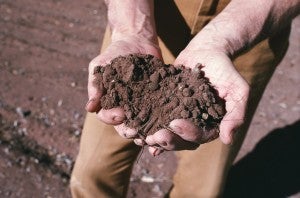The key ingredient in a resilient food supply: healthy soil

Last year, the United Nations General Assembly declared December 5th as World Soil Day. This annual event aims to “connect people with soils and raise awareness of their critical importance in our lives.”
As the Food and Agriculture Organization of the U.N. notes, we often ignore soil’s key role in our food systems, climate, and in sustaining biodiversity. Today, 33 percent of the planet’s soils are considered degraded – and this has vast implications for meeting the world’s growing demand for food.
In honor of World Soil Day, I asked Nick Goeser, Ph.D., soil health and sustainability manager for the National Corn Growers Association, to elaborate on why soil really matters.
How is soil health tied to food production?

Many research studies have illustrated how farm management practices can improve or reduce the ability of a soil to produce food consistently. For example, soil management practices resulting in erosion have been tied to yield reductions of up to 90 percent across the globe.
In order to ensure a resilient food supply, we need to protect productive soils and improve impaired soils by adopting best soil management practices. In addition, we need to keep in mind the time required to see improvements in soil health. Nitrogen, phosphorus, and potassium levels within a soil can be changed within days, but active organic matter, soil stability and active carbon levels can change over years. And soil depth normally changes over thousands of years.
What does it mean for soil to be degraded, and why is degradation a problem?
Soil degradation implies a reduction in soil functioning and soil health. Soils support plant growth. They recycle nutrients, and provide a habitat for soil organisms. A loss of one, or multiple, soil functions will reduce its productivity.
There are many symptoms of soil degradation, including increased crusting, increased erosion, decreased nutrient cycling, reduced water regulation, increased salinization, and increased desertification. These symptoms vary across the United States and the planet and also vary in the time required to reverse the effects. All the symptoms of degradation result in a decrease in soil health and in the ability of a given soil to support the full potential of plant.
What are the biggest threats to soil health in the U.S.?
The biggest threats to soil health in the United States include losses in organic matter, topsoil losses through wind, water and tillage erosion, and prime agricultural land losses to urban expansion. These threats all have a potentially great impact on soil productivity and food production. Although the time required to reverse these losses varies, we do have options available to protect against the threats.
What is the best way to restore soils? What can farmers do to ensure we have healthy soils for future generations?
We first need to evaluate the current health of soils to be able to measure improvements over time. Farmers can start with a small area (20-80 acres) on the farm to take soil health assessments for a baseline. After the baseline has been set, farmers can identify two main soil properties they would like to improve, such as soil organic matter content, soil water-holding capacity or nutrient-use efficiency and cycling.
Next, farmers can decide on the tools to improve the soil, while recognizing no tool is a silver bullet to fix all the problems. These tools could be cover crops (single species or mix), conservation tillage, prescription nutrient management or others. Just like the adoption of any new technology on the farm, it will take time to learn how best to use these tools.
The most important thing is not to give up after one year. Keep trying and reach out to other local farmers and agricultural organizations, and find national, state and local resources to help. Some of these organizations include the Soil Health Partnership, Environmental Defense Fund, Conservation Technology Information Center, The Nature Conservancy, USDA-NRCS offices, local soil and water conservation district offices, and many others.












